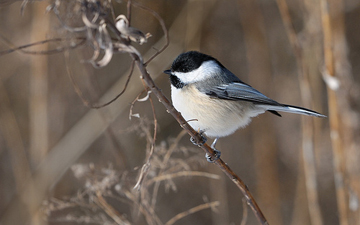The Black-capped Chickadee (Poecile atricapillus) is a small, common songbird, a passerine bird in the tit family Paridae. It is the state bird of both Maine and Massachusetts, and the provincial bird of New Brunswick in Canada.
The Black-capped Chickadee has a black cap and bib with white sides to the face. Its underparts are white with rusty brown on the flanks and its back is gray. It has a short dark bill, short wings and a long tail. Males are larger. The tail is normally primarily slate-gray but has been observed in central New Jersey in 2008 to be completely white and seemingly longer and more prominent than the normal gray tail. At least one other such white tail has been observed as a documented change occurring in one individual (banded) bird. [1]
The breeding habitat of the Black-capped Chickadee is mixed or deciduous woods in Canada, Alaska and the northern United States. The Black-capped and Carolina chickadees are extremely similar visually, but distinguishable by subtle differences. They were formally thought to be easily distinguished by call, but the two species often learn each others vocalizations where their ranges overlap. A bird located near the zone of overlap that sings both songs, or sings “odd-sounding” songs, cannot be positively identified in the field[1]. Their point of overlap is a narrow band that runs along the east-central United States.
(From Wikipedia, May 14th, 2010)
– – –





